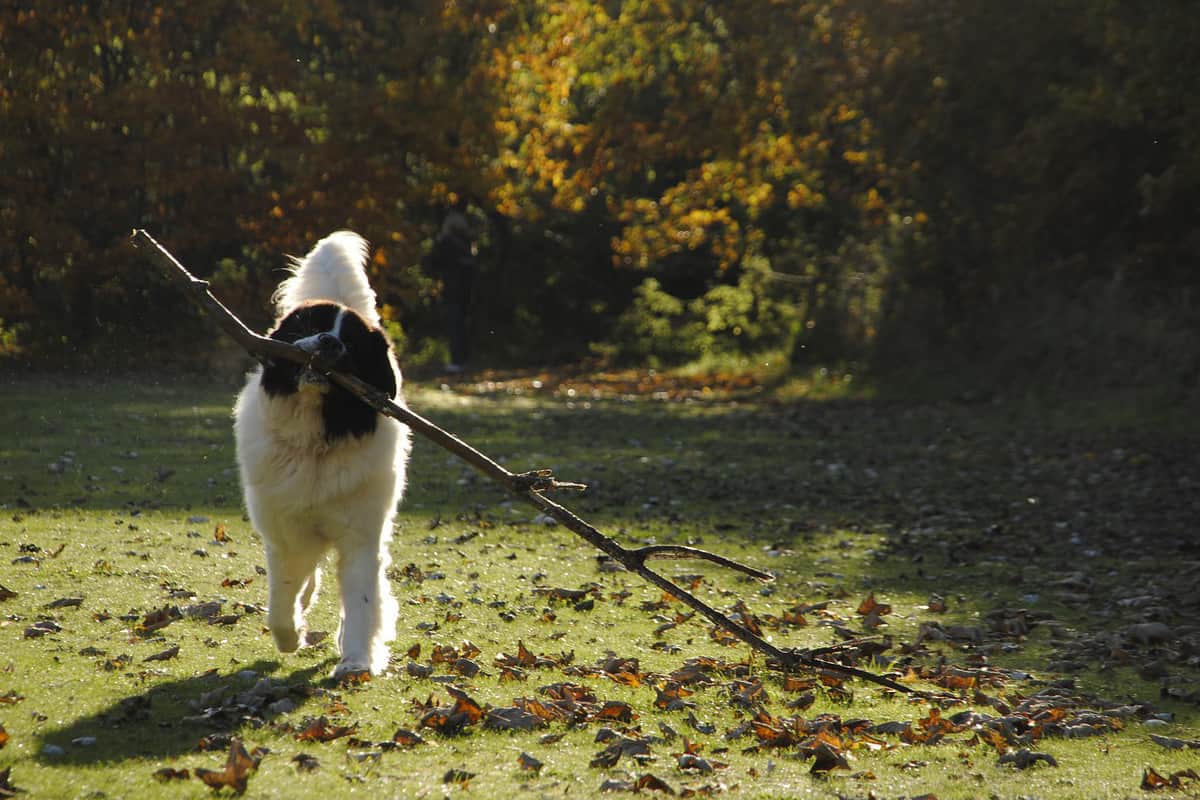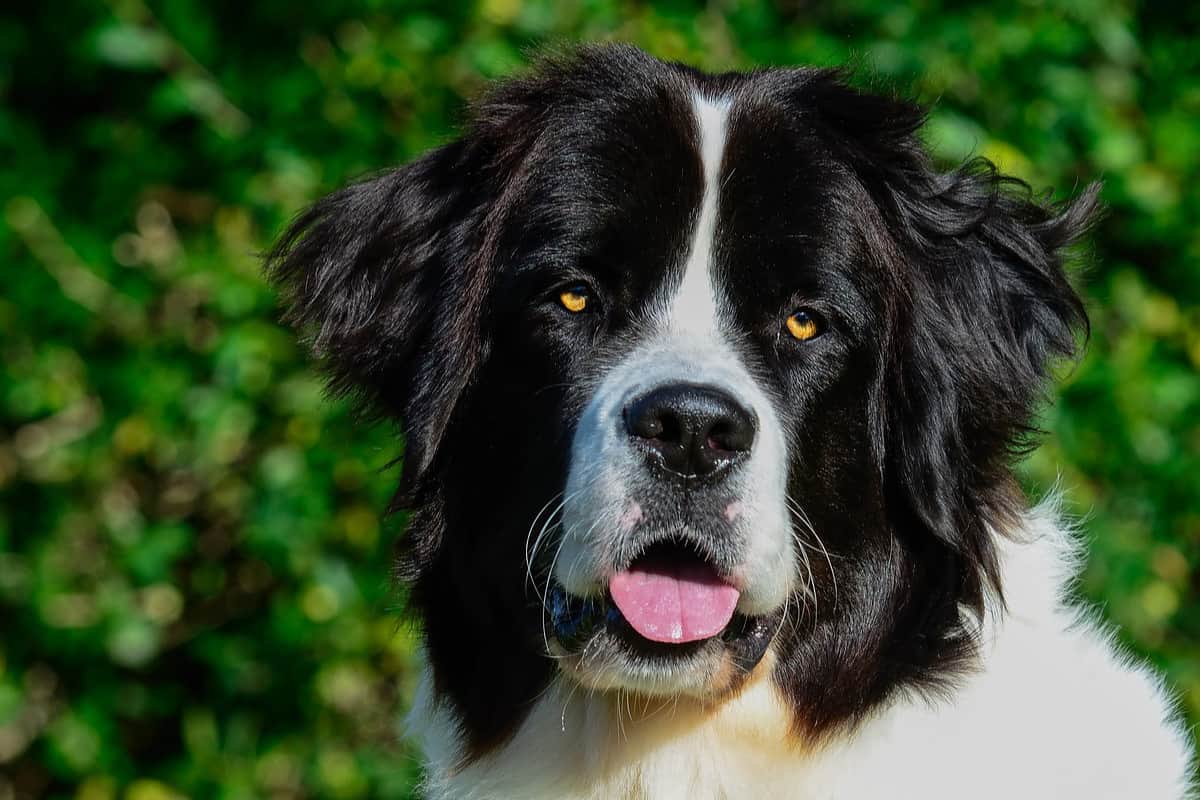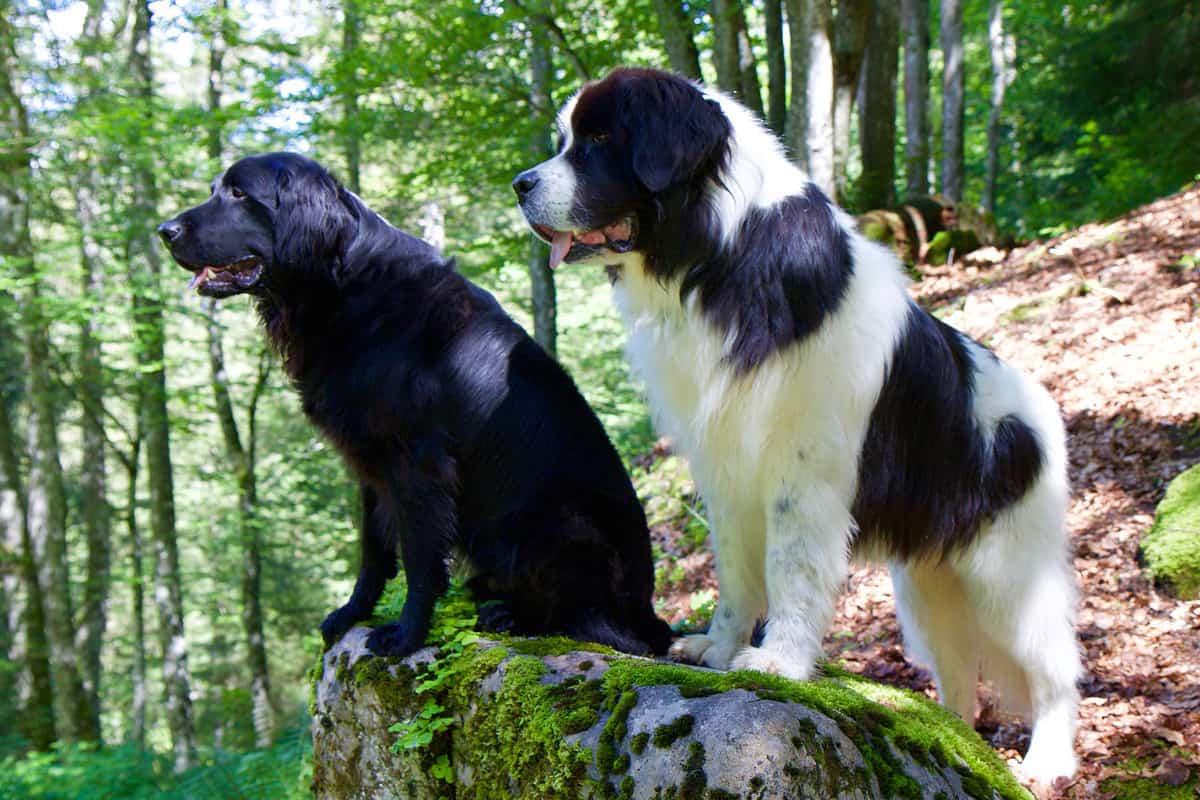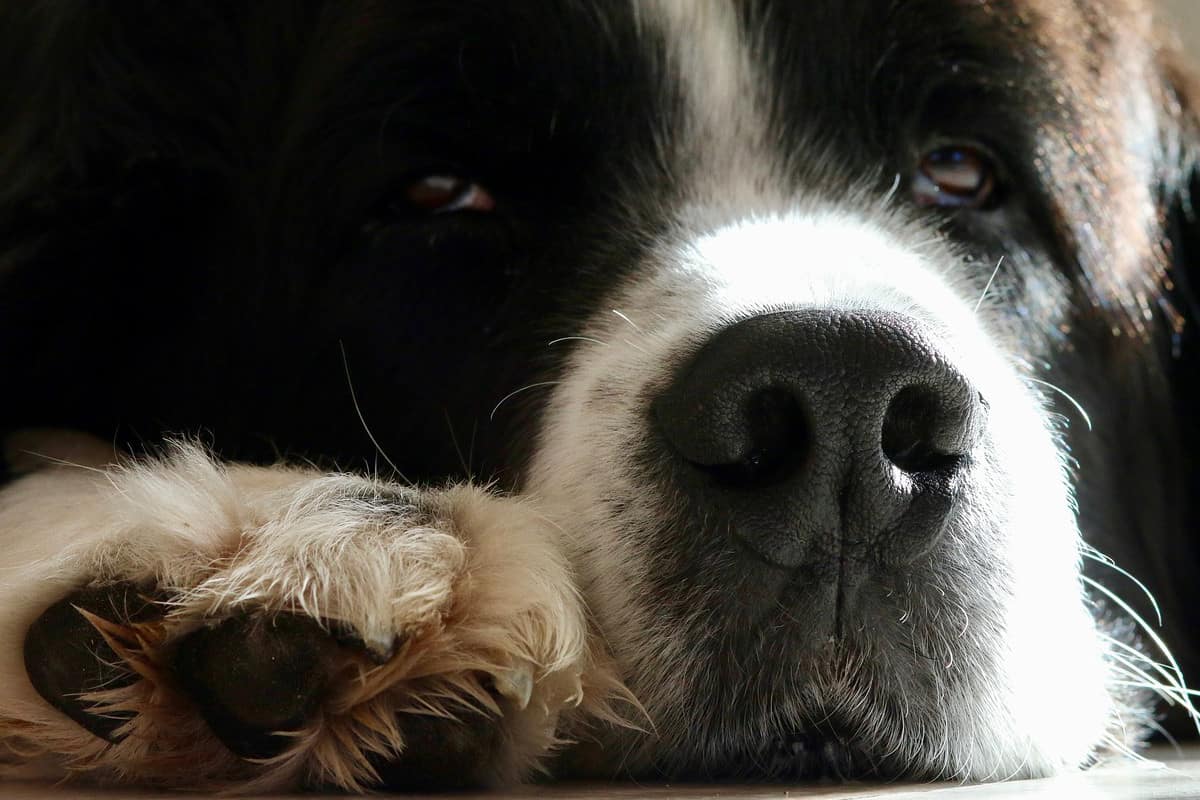The Landseer is a variation of the popular Newfoundland breed. They are intelligent, gentle working dogs, with a generally good temperament.
By origin, the Landseer is possibly descended from indigenous water dogs and will love a good swim!
Furthermore, they will always stand between their owner and any impending danger, due to their outstanding loyalty and courage.
Below, we’ve created a comprehensive guide to the breed, and what you can expect if you decide that a Landseer is the dog for you!
Table of Contents
Landseer Breed Information: A Comprehensive Guide
Personality
Landseers are model dogs, in terms of their temperaments.
Much like the ‘teacher’s pet’, they will stand beside their owner in any scenario, a testament to their loyalty, courage, and love for their owners.
As an intelligent breed, the Landseer will take well to training.
However, the Landseer’s puppy stage lasts a little longer than other breeds, so patience will be required with them for the first 18 months or so.
Similarly, their sweet and gentle nature makes them a family favorite!
The Landseer craves human attention. Their sweet and gentle nature makes them a family favorite!
They really do love being around children and families and are noted to enjoy lounging around your living area.
However, prospective owners of a Landseer need to remember that they are guardian dogs, and whilst they aren’t aggressive, they will need to be taught who is their friend.
Otherwise, they have been known to become protective over the home when new people are not properly introduced.
Owners/prospective owners of Landseers need to remember that, whilst they might be gentle giants, they are pretty big!
Therefore, small children should be supervised when playing with a Landseer, as there is a risk that the breed can accidentally knock over or unintentionally injure a smaller child.
The Landseer is a good dog for new or inexperienced dog owners.
Physical Characteristics

To address the elephant in the room, we need to discuss the fact that the Landseer is a very large dog.
Males can measure up to an impressive 31 inches in height, whilst females can be around 28 inches tall. In comparison, an average Golden Retriever is around 24 inches tall.
The male Landseer can weigh between 143lbs and 176lbs, with the female sitting between 110lbs and 150lbs on the scales.
The Landseer has a thick, wavy undercoat with a long, water-repellent overcoat.
The Landseer’s coat (a defining feature of the breed) is not hypoallergenic, so owners with allergies should consider this carefully before buying one.
The main coat color is white and black, although it is possible to find sandy/golden Landseers as well as brown and white versions.
The Landseer is described as a ‘tall, well balanced, and powerful dog’.
It has a medium-sized tail, a large broad head, triangular ears, and a medium-length broad muzzle.
The Landseer is actually slightly more agile than the classic Newfoundland; however, it isn’t as nimble as other herding/guard dog breeds.
It is an extremely strong swimmer – thanks to its water dog roots – and has been known to be used in water rescue as well as hauling fishing nets in for fishermen.
Important Note For Prospective Landseer Buyers
In the US and the UK, the Landseer is considered the same breed as the Newfoundland, so you may actually end up buying either/or.
The breeds are very similar, yet the length of the legs and overall size differs. In most European countries, there is a distinct name differentiation.
History of Landseers

The exact origin of the Landseer isn’t known; however, it is believed to have come from the Newfoundland region of Canada as a descendant of the extinct St John’s Water Dog.
Thought to be a distant relative of the Great Pyrenees, Great Dane, and Mastiff, the Landseer was developed to assist fishermen with retrieving nets from the water.
In the 1800s, the black and white Newfoundland was heavily bred in the Netherlands and Germany, and it’s possible the Landseer followed suit.
Their distinctive black and white coat pattern became known as the ‘Landseer coat’ after a painting by Sir Edwin Landseer in 1838.
Fun Fact About Landseers
The Newfoundland breed (generally) was first developed in two varieties: the lesser Newfoundland, and the greater Newfoundland.
The latter stayed mainly in Canada and developed into what we know as the Newfoundland and Landseer, however the former was actually bred into what we know as the Labrador retriever.
The American Kennel Club, the Kennel Club of England, and the Canadian Kennel Club all consider the Landseer to be a variety within the Newfoundland breed, rather than its own specific breed.
They usually cost around $1500 in the US directly from a breeder.
How Easy Is It To Train A Landseer?

The Landseer is quite an intelligent dog, therefore will respond well to training.
Both training and socialization need to start early, to correct any behavioral problems as a puppy. However, this can also be said of any dog.
Positive reinforcement-based training is preferred for this breed, so remember to keep some treats handy!
Prospective or new owners of a Landseer should note that the breed, due to its size, can be physically slow when moving or responding to a command, and this shouldn’t be punished.
Owners note that the Landseer’s recall is generally good.
Your Landseer will most likely want to swim, which is great in many ways. However, water presents significant risks for your puppy.
Make sure that your Landseer puppy’s jabs are all up to date, to reduce the risk of the dog contracting water-borne diseases.
Similarly, stagnant bodies of water with blue-green algae should be avoided at all costs.
Ensure that the area in which your Landseer puppy or dog is swimming contains no underwater debris. Buying a paddling pool for your Landseer puppy may be a good place to start.
Certain types of training will be more beneficial than others…
The Landseer is prone to separation anxiety, especially when they are away from their master (the designated ‘lead owner’ in your household).
Because of this, it’s important to start crate training early and to accustom them to being on their own for periods of time during the day.
Furthermore, it may be wise to place an emphasis on heel walking and lead training in the early days.
Due to the size and strength of the Landseer, you won’t want him/her to be pulling on the lead, nor will you want your pet to be bounding off towards strangers who are unsuspecting of a ‘hello’ from a rather large dog!
When you do come to teaching tricks, you must remember that puppies have very short attention spans.
It’s better to spend 15-20 minutes training your Landseer, many times a day, rather than spending one or two hours with your Landseer solidly, focusing on one trick, once a day.
Remember, Landseers are very sensitive to your tone of voice. Don’t shout, but rather be firm and direct.
Same thing, same time, every day…
As with any puppy, a rigid daily schedule must be in place.
The puppy must be waking up at virtually the same time daily, being fed and toileted at the same time every day, and has to be played with at consistent intervals.
With a Landseer, one one-hour walk per day should suffice exercise-wise, although it should be noted that any puppy should not be walked excessively, due to their developing bone structure.
Without a routine, your Landseer puppy may start to think that they’re the king of the castle, causing disruptive behavior.
At home, ensure that they experience plenty of different sights, smells, and sounds.
You don’t want to scare your Landseer puppy, but they need to become accustomed to everyday sounds such as the vacuum cleaner.
Landseer Grooming Needs

The Landseer, like many other breeds, will have seasonal coat ‘blowouts’, which is where the undercoat is fully shed twice a year.
The breed will need to be brushed at least once a day.
Firstly, you should brush against the growth of the hair with a slicker brush to remove any tangles, and then normally with a medium or wide-toothed comb.
Brushing prevents your Landseer’s coat from matting.
Matting can be painful for a dog, and the best way to avoid putting your dog in unnecessary discomfort is by brushing him or her regularly.
Moreover, you don’t want loose hairs all over your house!
Brushing at home will also save money in the long run, as you will not have to hire a professional groomer to weed out the tougher tangles in your Landseer’s coat.
Ensure you introduce your Landseer to grooming early, as it is both a good bonding technique and shows your Landseer that the brush is neither a threat nor a toy.
Of course, when your dog is dirty you don’t really want him cuddling up on the sofa with you.
However, you must be aware that full bathing strips away the coat’s natural oils.
Therefore, it’s recommended that you dry shampoo from time to time, with monthly or two-monthly baths.
Teeth brushing is also a necessity for your Landseer. This should be done between 2 and 3 times a week. Similarly, it’s recommended that you clip your Landseer’s nails monthly.
When doing so, be careful to not clip too close to the root as there are sensitive blood vessels in the area that will bleed if snipped!
Relationship with the family
The Landseer is a great family dog, but only if your family spends adequate time in the house with it.
You see, the Landseer is prone to developing separation anxiety, and whilst it can be argued that this can be trained out of a dog, separation anxiety is rooted in the Landseer’s DNA.
This may be an area where you have to have an honest look at yourself as a prospective dog owner, and think, ‘Am I actually able/prepared to spend time with my new dog’.
If spending adequate time with your puppy and growing or adult dog will present a problem, then you really need to consider whether getting one would be fair on you or the dog.
However, the Landseer doesn’t need excessive amounts of exercise. It will require one, one hour walk per day, and playtime at one other point.
The Landseer is a bit of a couch potato, so you won’t be burdened with a need to be out walking miles.
However, like any dog, if they get very bored, they can display destructive behaviors.
Are Landseers good for small children?
The Landseer is not a hunting dog, but rather a guardian and therefore does not have a high prey drive.
This makes them a good dog for young children to be around; however, due to the Landseer’s size, small children should not be left alone with the dog.
This principle applies to all dogs, not just the Landseer.
House types
Landseers will thrive in a house with a decent-sized yard; however, providing they receive enough outdoor exercise, then they can live in an apartment.
Landseer Tendencies

There are four main tendencies that the Landseer displays.
Firstly, the Landseer is prone to separation anxiety.
They do not react well to being left for long periods of time, especially without their master, and therefore will not make good dogs for people who are constantly out of the house.
They need substantial time with their master and are more ‘indoor’ dogs rather than ‘outdoor’ dogs.
Due to their thick coat and stocky, solid build, the Landseer doesn’t enjoy the heat.
Your Landseer will need to have a shady area to cool off in during hotter summer months, and it’s important to keep them hydrated. Be aware that the Landseer is a bit of a messy drinker!
Now, if you love a spotless house and immaculate clothes, then you may want to take into account the fact that the Landseer drools a lot more than the average dog.
This is quite common amongst large breeds, due to their shorter noses and looser skin around the mouth.
In terms of physical health, the Landseer is prone to hip dysplasia.
Other noted problems potentially include elbow dysplasia, bloat (this can be aided by purchasing a slow feeder bowl for your Landseer), heatstroke, obesity, and sub-aortic stenosis (SAS)
How Much Should You Feed A Landseer?
Large breed dog food is recommended for the adult Landseer. Feed your Landseer twice a day. Remember to consult your vet for advice on the right food for your specific dog.
Are You The Right Person To Own A Landseer?
So, you’ve read all about them, and now it’s time to decide if the Landseer is the dog for you.
If you are looking for a kind, gentle, and protective family dog, and don’t have huge amounts of time to dedicate to exercise, then the gorgeous Landseer may well be the dog for you!
Resources:
